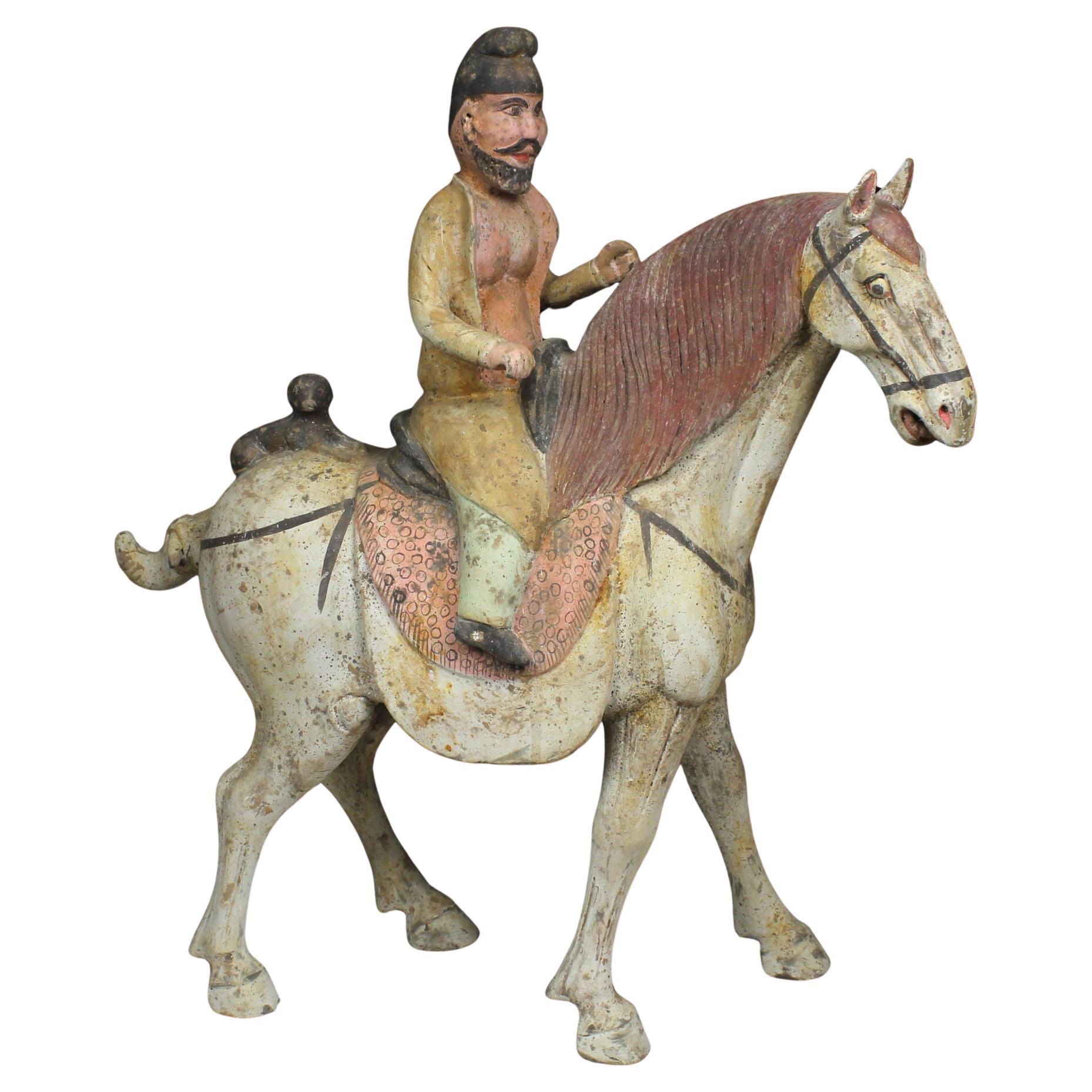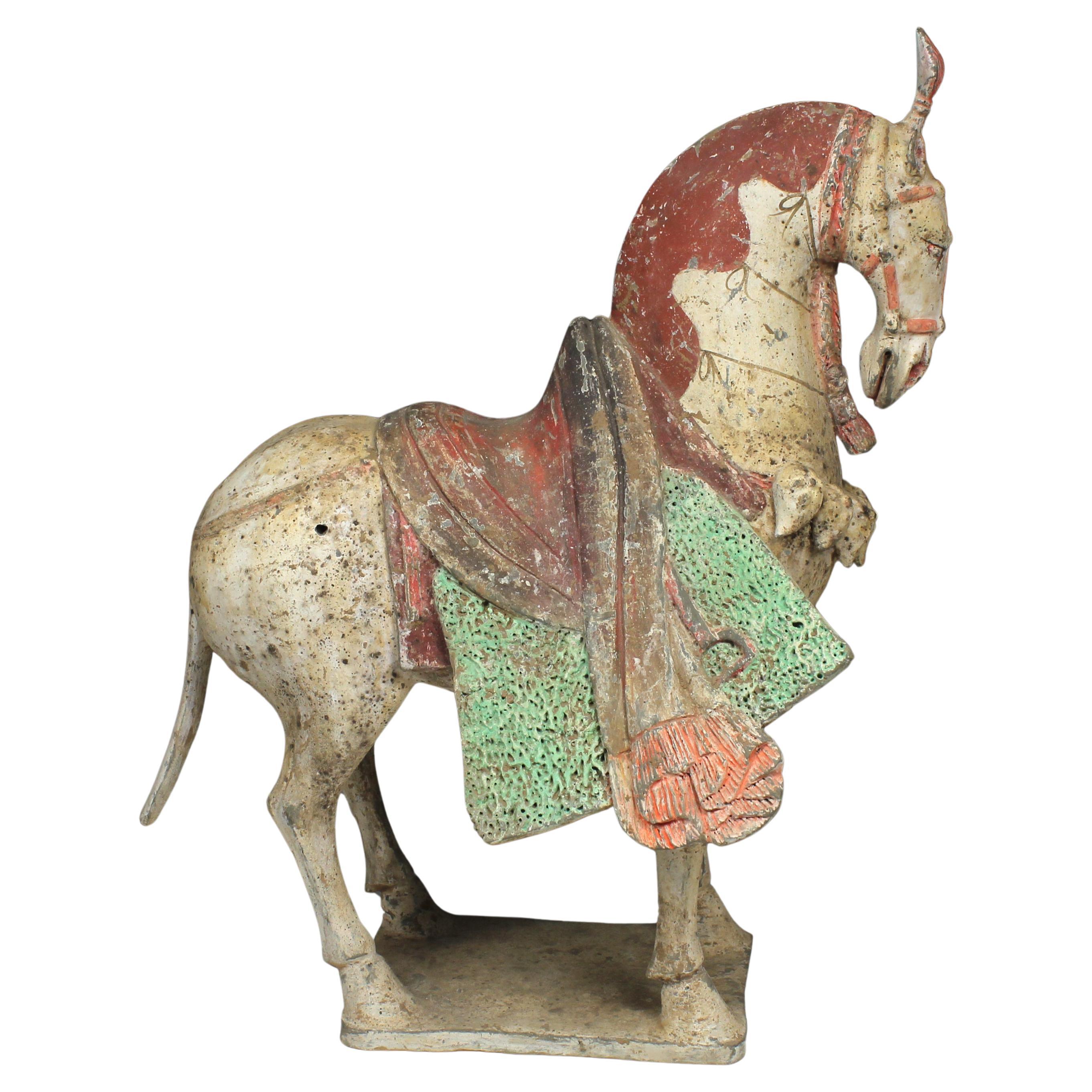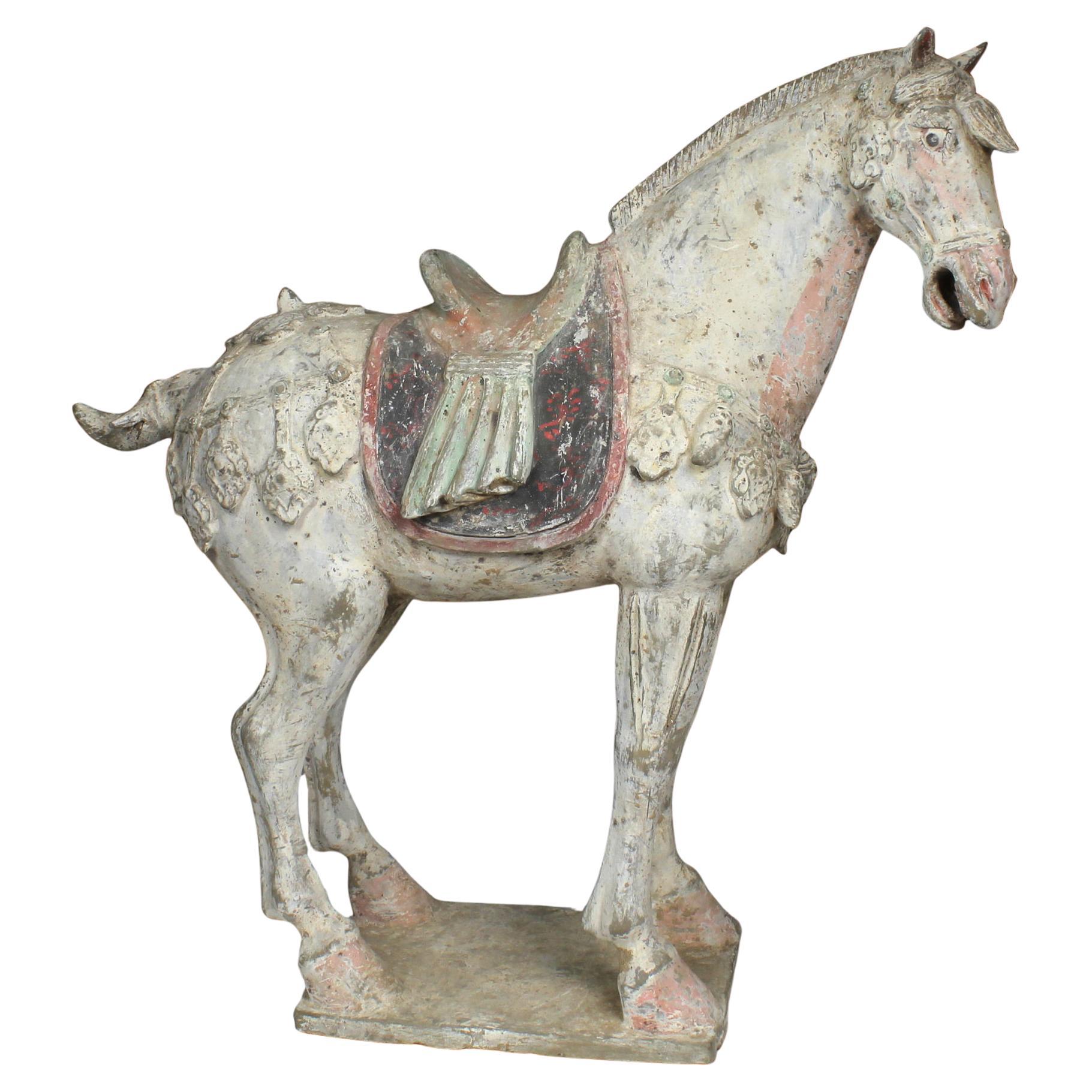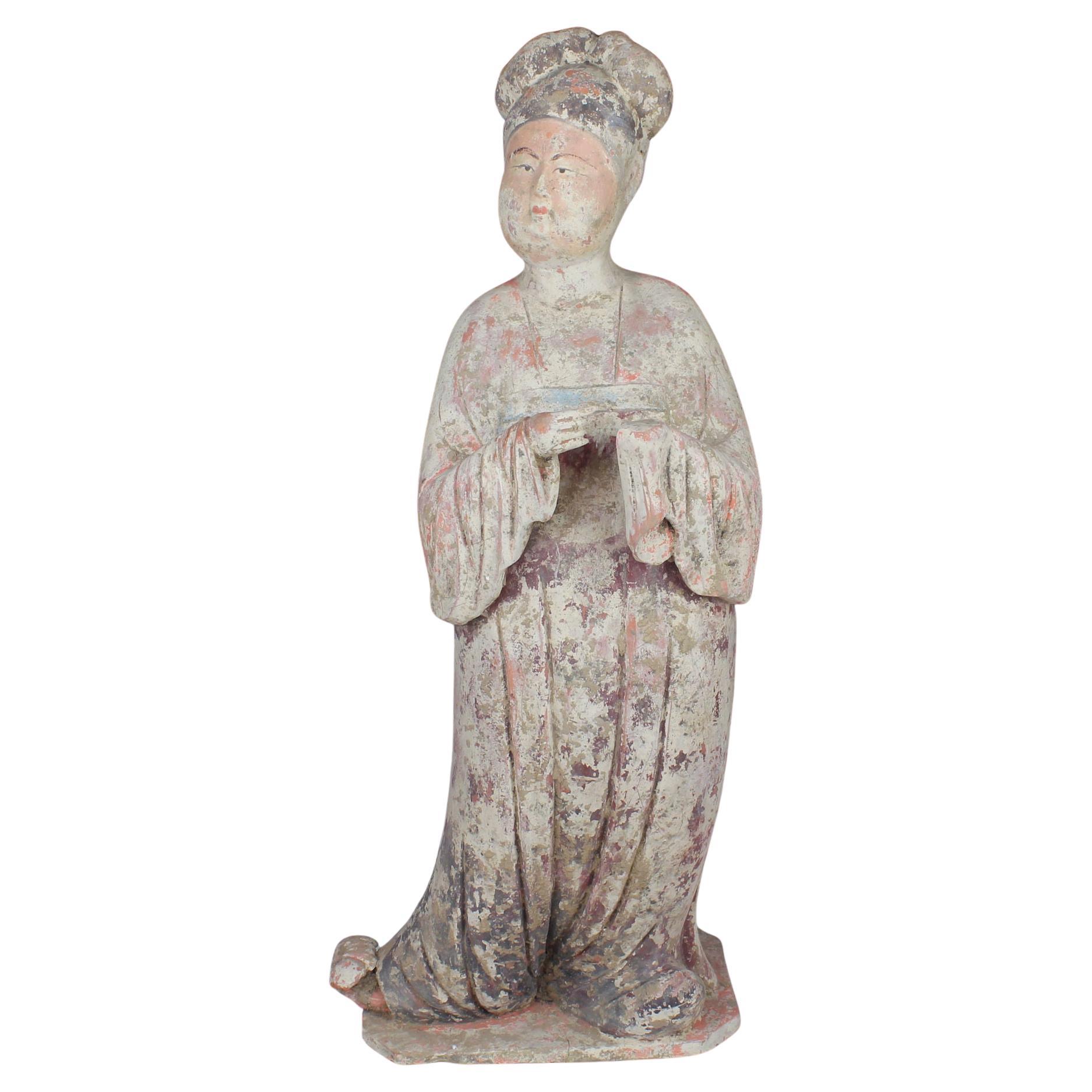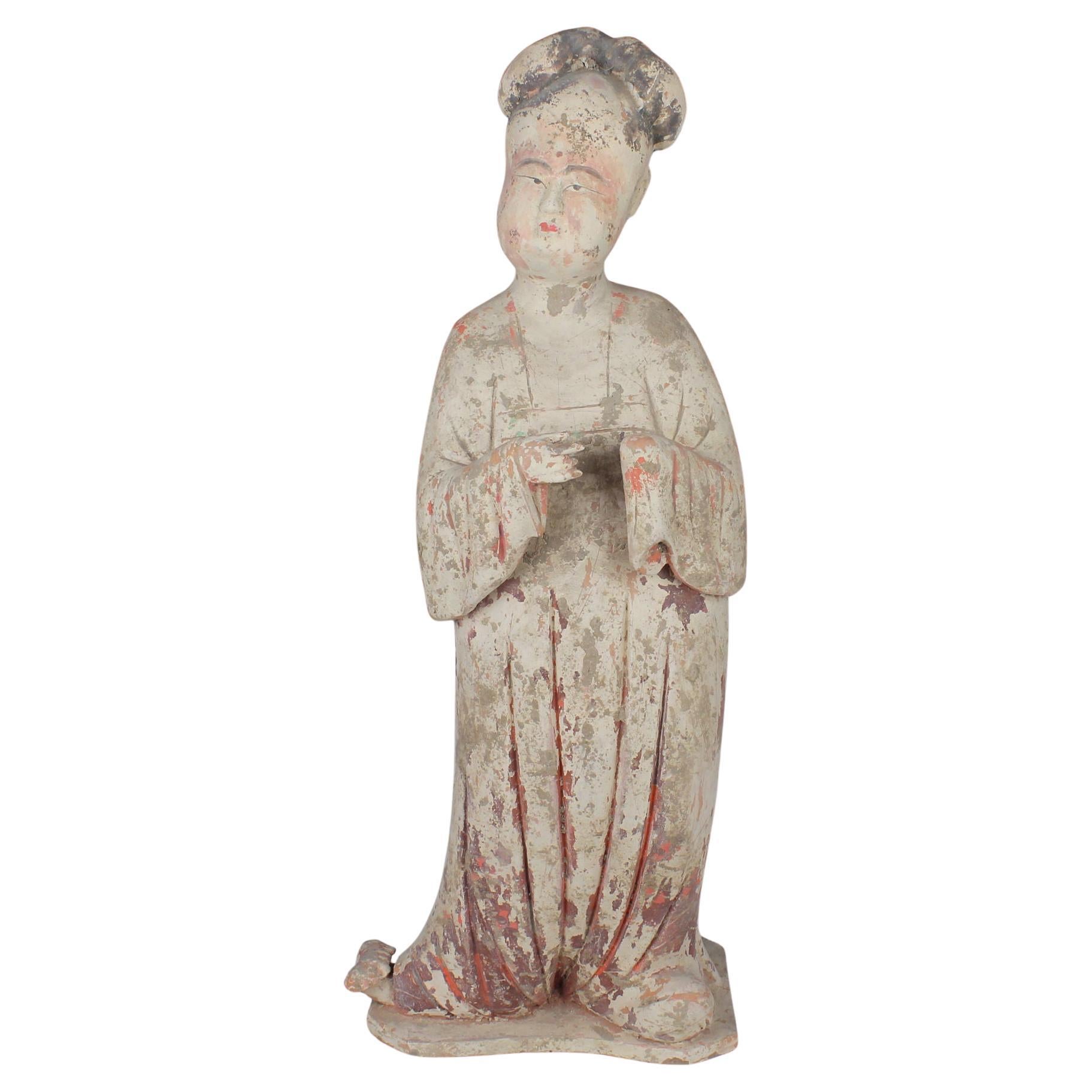Items Similar to Chinese statuette of a horse with rider
Want more images or videos?
Request additional images or videos from the seller
1 of 9
Chinese statuette of a horse with rider
About the Item
ITEM: Statuette of a horse with rider
MATERIAL: Pottery
CULTURE: Chinese, Tang Dynasty
PERIOD: 618 – 907 A.D
DIMENSIONS: 520 mm x 420 mm x 180 mm
CONDITION: Good condition. Includes Thermoluminescence test by Laboratory Kotalla (Reference 51PR210621)
PROVENANCE: Ex Belgian private collection (2022), Ex English art gallery, Ex English private collection, acquired from Hong Kong art market in 1990s
Comes with Certificate of Authenticity and Export Licence. If you are from outside the European Union, we will have to apply for the export licence again for your country, this takes 4 to 6 weeks.
Due to the fragility and size of this piece, it can only be shipped within the European Union, United Kingdom and neighbouring countries that can be transported by road by private courier (door to door).
The Tang Dynasty (618-907 AD) in China was renowned for its vibrant cultural scene and artistic achievements, and one of the notable facets of its artistic expression was the production of Minqi figures. Minqi, which translates to “folk art,” encompassed a wide range of artistic forms created for everyday use and enjoyment. These figures were crafted by skilled artisans and represented various aspects of daily life, including depictions of people from different social classes, occupations, and activities.
Minqi figures from the Tang Dynasty provide valuable insights into the cultural and social life of the time. They depict scenes from daily life, such as musicians playing instruments, dancers performing, scholars reading, merchants conducting business, and farmers tending to their fields. These figurines capture the diversity and dynamism of Tang society, illustrating the mingling of different social strata and the vibrancy of urban and rural life during this period.
Crafted from materials such as ceramic, pottery, and occasionally metal, Tang Dynasty Minqi figures were meticulously detailed and displayed a high level of craftsmanship. Artisans paid close attention to facial expressions, clothing, and accessories, infusing these figures with a sense of realism and vitality.
唐朝(618-907年)是中国历史上文化繁荣和艺术成就辉煌的时期,其艺术表达的一个显著方面是民器人物。民器是指各种为日常生活和娱乐而创作的艺术形式。这些人物由熟练的工匠制作,代表了日常生活的各个方面,包括不同社会阶层、职业和活动的人物形象。
唐代的民器人物提供了宝贵的见解,展现了当时的文化和社会生活。它们描绘了日常生活中的各种场景,如音乐家演奏乐器、舞者表演、学者阅读、商人进行交易以及农民耕作。这些塑像捕捉了唐代社会的多样性和活力,展示了不同社会阶层的交融,以及这一时期城乡生活的丰富多彩。
唐代的民器人物通常由陶瓷、陶器等材料制成,偶尔也用金属制作,制作精细,工艺水平高。工匠们注重面部表情、服饰和配饰的细节,赋予这些人物形象逼真感和生动性。如今,唐代的民器人物被视为珍贵的文物,为我们提供了宝贵的见解,了解中国历史上最辉煌的王朝之一的物质文化、社会动态和艺术审美。
- Dimensions:Height: 20.48 in (52 cm)Width: 16.54 in (42 cm)Depth: 7.09 in (18 cm)
- Style:Tang (Of the Period)
- Materials and Techniques:
- Place of Origin:
- Period:
- Date of Manufacture:Tang Dynasty, 618 – 907 A.D
- Condition:Wear consistent with age and use.
- Seller Location:EL CAMPELLO, ES
- Reference Number:1stDibs: LU7382239036382
About the Seller
5.0
Vetted Seller
These experienced sellers undergo a comprehensive evaluation by our team of in-house experts.
Established in 2011
1stDibs seller since 2022
8 sales on 1stDibs
- ShippingRetrieving quote...Ships From: El Campello, Spain
- Return PolicyA return for this item may be initiated within 60 days of delivery.
More From This SellerView All
- Chinese statuette of a Sogdian riderLocated in EL CAMPELLO, ESITEM: Statuette of a Sogdian rider MATERIAL: Pottery CULTURE: Chinese, Tang Dynasty PERIOD: 618 – 907 A.D DIMENSIONS: 560 mm x 510 mm x 175 mm CONDITION: Good condition. Includes The...Category
Antique 15th Century and Earlier Chinese Tang Antiquities
MaterialsPottery
- Chinese statuette of a horseLocated in EL CAMPELLO, ESITEM: Statuette of a horse MATERIAL: Pottery CULTURE: Chinese, Northern Wei Dynasty PERIOD: 386 – 535 A.D DIMENSIONS: 404 mm x 350 mm x 230 mm CONDITION: Good condition. Includes Th...Category
Antique 15th Century and Earlier Chinese Tang Antiquities
MaterialsPottery
- Chinese statuette of a horseLocated in EL CAMPELLO, ESITEM: Statuette of a horse MATERIAL: Pottery CULTURE: Chinese, Tang Dynasty PERIOD: 618 – 907 A.D DIMENSIONS: 560 mm x 530 mm x 200 mm CONDITION: Good condition. Includes Thermolumin...Category
Antique 15th Century and Earlier Chinese Tang Antiquities
MaterialsPottery
- Chinese statuette of a horse with musicianLocated in EL CAMPELLO, ESITEM: Statuette of a horse with musician MATERIAL: Pottery CULTURE: Chinese, Tang Dynasty PERIOD: 618 – 907 A.D DIMENSIONS: 420 mm x 365 mm x 145 mm CONDITION: Good condition. Includ...Category
Antique 15th Century and Earlier Chinese Tang Antiquities
MaterialsPottery
- Chinese statuette of a Fat LadyLocated in EL CAMPELLO, ESITEM: Statuette of a Fat Lady MATERIAL: Pottery CULTURE: Chinese, Tang Dynasty PERIOD: 618 – 907 A.D DIMENSIONS: 655 mm x 265 mm x 210 mm CONDITION: Good condition. Includes Thermoluminescence test by Laboratory Kotalla (Reference 05B101123). Includes Certificate of Authenticity from Dutch gallery PROVENANCE: Ex Belgian private collection, acquired from Dutch art gallery Comes with Certificate of Authenticity and Export Licence. If you are from outside the European Union, we will have to apply for the export licence again for your country, this takes 4 to 6 weeks. Due to the fragility and size of this piece, it can only be shipped within the European Union, United Kingdom and neighbouring countries that can be transported by road by private courier (door to door). This beautifully-finished ceramic attendant was made during what many consider to be China’s Golden Age, the Tang Dynasty. It was at this point that China’s outstanding technological and aesthetic achievements opened to external influences, resulting in the introduction of numerous new forms of self-expression, coupled with internal innovation and considerable social freedom. The Tang dynasty also saw the birth of the printed novel, significant musical and theatrical heritage and many of China’s best- known painters and artists. The Tang Dynasty was created on the 18th of June, 618 AD, when the Li family seized power from the last crumbling remnants of the preceding Sui Dynasty. This political and regal regime was long-lived, and lasted for almost 300 years. The imperial aspirations of the preceding periods and early Tang leaders led to unprecedented wealth, resulting in considerable socioeconomic stability, the development of trade networks and vast urbanisation for China’s exploding population (estimated at around 50 million people in the 8th century AD). The Tang rulers took cues from earlier periods, maintaining many of their administrative structures and systems intact. Even when dynastic and governmental institutions withdrew from management of the empire towards the end of the period – their authority undermined by localised rebellions and regional governors known as jiedushi –the systems were so well- established that they continued to operate regardless. The artworks created during this era are among China’s greatest cultural achievements. It was the greatest age for Chinese poetry and painting, and sculpture also developed (although there was a notable decline in Buddhist sculptures following repression of the faith by pro-Taoism administrations later in the regime). It is disarming to note that the eventual decline of imperial power, followed by the official end of the dynasty on the 4th of June 907, hardly affected the great artistic turnover. During the Tang Dynasty, restrictions were placed on the number of objects that could be included in tombs, an amount determined by an individual’s social rank. In spite of the limitations, a striking variety of tomb furnishings – known as mingqi – have been excavated. Entire retinues of ceramic figures – representing warriors, animals, entertainers, musicians, guardians and every other necessary category of assistant – were buried with the dead in order to provide for the afterlife. Warriors (lokapala) were put in place to defend the dead, while horses/ camels were provided for transport, and officials to run his estate in the hereafter. Of all the various types of mingqi, however, there are none more elegant or charming than the sculptures of sophisticated female courtiers, known – rather unfairly – as “fat ladies...Category
Antique 15th Century and Earlier Chinese Tang Antiquities
MaterialsPottery
- Chinese statuette of a Fat LadyLocated in EL CAMPELLO, ESITEM: Statuette of a Fat Lady MATERIAL: Pottery CULTURE: Chinese, Tang Dynasty PERIOD: 618 – 907 A.D DIMENSIONS: 645 mm x 260 mm x 180 mm CONDITION: Good condition. Includes Thermoluminescence test by Laboratory Kotalla (Reference 04B101123). Includes Certificate of Authenticity from Dutch gallery PROVENANCE: Ex Belgian private collection, acquired from Dutch art gallery Comes with Certificate of Authenticity and Export Licence. If you are from outside the European Union, we will have to apply for the export licence again for your country, this takes 4 to 6 weeks. Due to the fragility and size of this piece, it can only be shipped within the European Union, United Kingdom and neighbouring countries that can be transported by road by private courier (door to door). This beautifully-finished ceramic attendant was made during what many consider to be China’s Golden Age, the Tang Dynasty. It was at this point that China’s outstanding technological and aesthetic achievements opened to external influences, resulting in the introduction of numerous new forms of self-expression, coupled with internal innovation and considerable social freedom. The Tang dynasty also saw the birth of the printed novel, significant musical and theatrical heritage and many of China’s best- known painters and artists. The Tang Dynasty was created on the 18th of June, 618 AD, when the Li family seized power from the last crumbling remnants of the preceding Sui Dynasty. This political and regal regime was long-lived, and lasted for almost 300 years. The imperial aspirations of the preceding periods and early Tang leaders led to unprecedented wealth, resulting in considerable socioeconomic stability, the development of trade networks and vast urbanisation for China’s exploding population (estimated at around 50 million people in the 8th century AD). The Tang rulers took cues from earlier periods, maintaining many of their administrative structures and systems intact. Even when dynastic and governmental institutions withdrew from management of the empire towards the end of the period – their authority undermined by localised rebellions and regional governors known as jiedushi –the systems were so well- established that they continued to operate regardless. The artworks created during this era are among China’s greatest cultural achievements. It was the greatest age for Chinese poetry and painting, and sculpture also developed (although there was a notable decline in Buddhist sculptures following repression of the faith by pro-Taoism administrations later in the regime). It is disarming to note that the eventual decline of imperial power, followed by the official end of the dynasty on the 4th of June 907, hardly affected the great artistic turnover. During the Tang Dynasty, restrictions were placed on the number of objects that could be included in tombs, an amount determined by an individual’s social rank. In spite of the limitations, a striking variety of tomb furnishings – known as mingqi – have been excavated. Entire retinues of ceramic figures – representing warriors, animals, entertainers, musicians, guardians and every other necessary category of assistant – were buried with the dead in order to provide for the afterlife. Warriors (lokapala) were put in place to defend the dead, while horses/ camels were provided for transport, and officials to run his estate in the hereafter. Of all the various types of mingqi, however, there are none more elegant or charming than the sculptures of sophisticated female courtiers, known – rather unfairly – as “fat ladies...Category
Antique 15th Century and Earlier Chinese Tang Antiquities
MaterialsPottery
You May Also Like
- Chinese Tang Dynasty Sancai Glazed Horse and Rider, TL Tested, ChinaLocated in Austin, TXA fine and unusual Chinese Tang Sancai glazed model of a horse and rider, Tang Dynasty (618 to 906 CE), early 8th century, China. This fantastic sculpture portrays a male figures se...Category
Antique 15th Century and Earlier Chinese Tang Antiquities
MaterialsEarthenware, Pottery
- Pair of Chinese Painted Pottery Han Dynasty Horse and RidersLocated in Austin, TXA pair of Han Dynasty (206 BC-220 AD) painted pottery horse and riders, China. The horses modeled standing foursquare, supporting their eque...Category
Antique 15th Century and Earlier Chinese Han Sculptures and Carvings
MaterialsPottery
- Tang Dynasty Painted Pottery Horse and Rider, TL TestedLocated in Austin, TXA charming Tang dynasty painted pottery figure of a horse and mounted noble rider. TL tested by Oxford Authentication. The horse portrayed standing fours...Category
Antique 15th Century and Earlier Chinese Tang Antiquities
MaterialsEarthenware
- Cast Iron Indian Game with Rider and HorsesLocated in Milano, ITWelded cast iron toy from the Indian 900s depicting a chariot with a square canopy and conical dome. We can identify this toy-statue as a depiction of Krishna’s Rath Gita (Bhagavad Gita...Category
Antique Early 1900s Indian Anglo-Indian Antiquities
MaterialsIron
- China 618-907 Ad Tang Dynasty Ancient Earthenware Sculpture of a Walking HorseLocated in Miami, FLStanding horse from the Tang Dynasty 618-907 AD. Beautiful sculptural piece of art from the Chinese ancient period of the Tang Dynasty (618-907 AD) featuring the finely sculptural figure of a horse, carefully made of earthenware clay pottery. The horse is standing in a very elegant and majestic position striding the four legs crossed. The animal has a slightly arched neck to the left looking forward and its extremely well modeled. The body is embellished with a beautiful saddle and intricate harnesses. The surface is treated with applications of natural color pigments such; white, light red and grays. Has a measurements of 343 mm by 140 mm by 356 mm (13.5 x 5.5 x14 Inches) (34.3 x 14 x 35.6 Cm). Tang dynasty or Tang Empire, was an imperial dynasty of China that ruled from 618 to 907, with an interregnum between 690 and 705. It was preceded by the Sui dynasty and followed by the Five Dynasties and Tend Kingdoms period. Historians generally regard the Tang as a high point in Chinese civilization, and a the golden age of cosmopolitan culture. Tang territory, acquired through the military campaigns of its early rulers, rivaled that of the Han dynasty. The Li family founded the dynasty, seizing power during the decline and collapse of the Sui Empire and inaugurating a period of progress and stability in the first half of the dynasty's rule. The dynasty was formally interrupted during 690–705 when Empress Wu Zetian seized the throne, proclaiming the Wu Zhou dynasty...Category
Antique 15th Century and Earlier Chinese Tang Antiquities
MaterialsEarthenware, Pottery
- Antique Chinese Opium Box in Hammered Brass, Decorated with a Scene of a RiderLocated in Leuven , BEThe cylindrical opium container is executed in hammered brass and decorated with an expressive repose design of a rider in a landscape with blossom tre...Category
20th Century Chinese Antiquities
MaterialsBrass
Recently Viewed
View AllMore Ways To Browse
Antique Hong
Dog Pottery Dynasty
Midcentury Modern Coffee Table And Side Tables
Vintage Modern Upholstered Chairs
Italian Chrome And Glass Tables
Italian Glass And Chrome Tables
Embassy Silver
Hand Painted Black Table
New Danish Dining Chairs
13 Vase
Built Ins
Vintage Corner Piece
Wood Chair Danish 1960s
Set Of Two Lights
Glass And Brass Vintage Pendant Light
Box On Feet
Vintage Table Set With Chairs
Patterned Top Side Table
